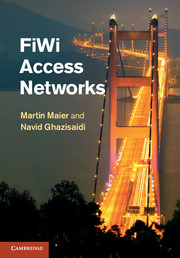4 - EPON
from Part II - Fiber access networks
Published online by Cambridge University Press: 05 January 2012
Summary
Ethernet passive optical network (EPON) has gained a great amount of interest both in industry and academia as a cost-effective solution for broadband access networks, as illustrated by the formation of several forums and working groups, including the EPON forum and the Ethernet in the First Mile (EFM) alliance. EPON carries data encapsulated in Ethernet frames, which makes it easy to carry IP packets and eases the interoperability with installed Ethernet local area networks (LANs). EPON represents the convergence of low-cost Ethernet equipment [switches, network interface cards (NICs)] and low-cost fiber architectures. Furthermore, given the fact that more than 90% of today's data traffic originates from and terminates in Ethernet LANs, EPON appears to be a natural candidate for future first-mile solutions.
The main standardization body behind EPON is the IEEE 802.3ah task force. This task force developed the so-called multipoint control protocol (MPCP) which arbitrates the channel access among central office (CO) and subscribers. MPCP is used for dynamically assigning the upstream bandwidth (subscriber to service provider), which is the key challenge in the access protocol design for EPON. Note that MPCP does not specify any particular dynamic bandwidth allocation (DBA) algorithm. Instead, it is intended to facilitate the implementation of DBA algorithms.
To understand the importance of dynamic bandwidth allocation in EPON, note that the traffic on the individual links in the access network is quite bursty.
- Type
- Chapter
- Information
- FiWi Access Networks , pp. 51 - 64Publisher: Cambridge University PressPrint publication year: 2011



